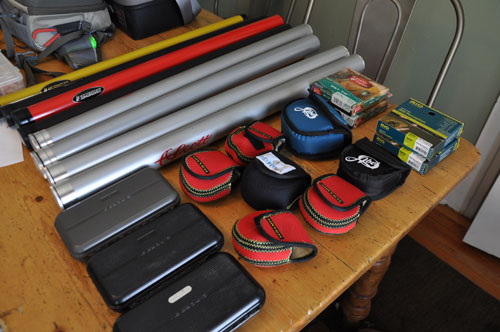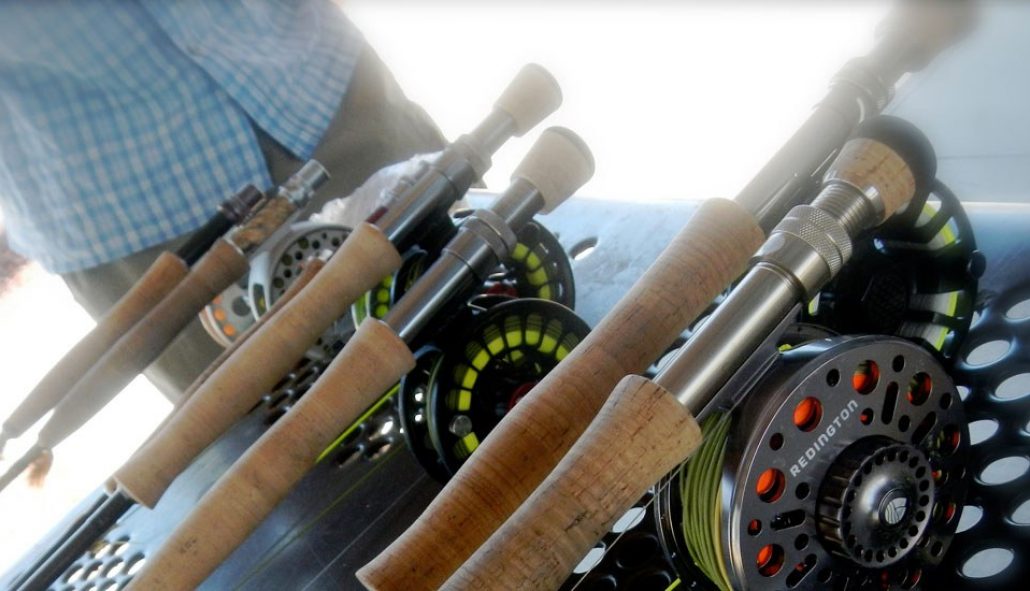For many of us, the fishing season never stops. 365 days a year....Game On.
 For the rest of the angling world though, Winter time typically means an end to the fishing season and a refocus to other more seasonably appropriate activities. If you happen to fall into this second group, properly storing your gear is something you should take seriously. Whether you're a bargain shopper or insist on always having the best-of-the-best, I'm still yet to meet an angler who doesn't take great pride in their fly-fishing gear. The good news is, proper storage of your equipment isn't hard and will definitely extend the useful life of your gear.
For the rest of the angling world though, Winter time typically means an end to the fishing season and a refocus to other more seasonably appropriate activities. If you happen to fall into this second group, properly storing your gear is something you should take seriously. Whether you're a bargain shopper or insist on always having the best-of-the-best, I'm still yet to meet an angler who doesn't take great pride in their fly-fishing gear. The good news is, proper storage of your equipment isn't hard and will definitely extend the useful life of your gear.
We'll start with Waders and Boots. If you haven't done so before, washing your waders in the washing machine can be very beneficial in prolonging the life. Simms Fishing Products recommends using a gentle cycle and cold water for washing waders. It is very important to use powdered detergent and no fabric softeners! Aside from giving your waders a good cleaning, washing them will also aid in the breathability of your waders by cleaning out any clogged pores. Once washed, hang to dry indoors, both flipped inside and out. Once completely dry, hanging your waders by the shoulder straps through the off season is appropriate.
For your wading boots, using a basic, mild soap along with a soft or medium bristled brush should be sufficient for cleaning off any access dirt/debris. The important thing here to remember is that wading boots should always be dried out of the sun. This rule applies anytime of the year when your boots are wet. Never set your boots in direct sunlight to dry. Doing so can cause warpage, shrinkage and can be hard on the materials used in construction.
When it comes to storing your fly rods, a toothbrush is works great for scrubbing guides and reel seats to clean off dirt, debris, salt, etc. Make sure your rod and cork handle are completely dry before returning to the rod cloth. It's perfectly fine to store your fly rods in their cases, however laying them horizontally (as opposed to standing vertically) is what most rod manufacturers recommend. If possible, leave the caps off your rod tubes to allow the rods to "breathe" a little.
For your fly reels, take the spool off and use a toothbrush and warm water to clean out any dirt or debris that might have collected inside. With the quality of sealed drags available on most reels today, odds are there won't be much to clean. Click/Pawl reels on the other hand can definitely collect dirt around the pawls, gears, etc and may require a little scrubbing. Depending on the brand of reel you have, a little oil may be recommended to keep your drag system lubed and properly working. Check with your specific reel manufacturer to see if this is advised. The biggest rule with oiling reels is that less is more.
Fly Lines are one of the top fly-fishing items than can get their life extended by properly storing. Many manufacturers make specific line cleaners to be used with their products which work great. Otherwise, using some warm water and a wash rag will do a great job at cleaning off any dirt/grime that may have collected on yoru line. This is also a great time to check your fly line for cracks or nicks. If upon inspection you find significant signs of wear, it might be a good idea to add a new line to your holiday gift list. Otherwise, if your line still has some life left in it, the ideal method of storage is to take the line off your reel and hang in loose coils on a nail or wooden peg. (It's fine to leave your backing on the reel). Hanging the line in loose coils will prevent the development of significant memory from months of being wrapped tightly around the spool. If hanging your fly line is not possible, a coffee can works great to wrap it around. Should you choose to go this route, you don't even need to disconnect the line from the backing. Wrap the line and then put the connected reel in the actual coffee can for storage. Store them up in the top of your closet and find them ready to go come spring.
 Fly boxes don't require much preperation for storage, although it's not a bad idea to open up all your boxes and lay them out on a table to air out for a day or so. (or dry out in case any unnoticed moisture happened to develop). Putting your boxes back in your pack/vest and putting in the closet will work just fine. Leader and tippet should be kept in a cool, dry place as well. Keep in mind that monofilament leader/tippet does have a shelf life of 6 months-1 year (depending on level of use). At around $4 a spool, mono doesn't typically hurt peoples bank accounts too hard. If you're unsure on the life of your mono, throw away the partial spools and restock with fresh come Spring. They say one of the best tools an angler can have in their tackle box is confidence. Being confident in your equipment will go a long way when it comes to putting your gear to the test. The last thing you want is to hook up with a big springtime Rainbow and have it break off because your tippet was rotten.
Fly boxes don't require much preperation for storage, although it's not a bad idea to open up all your boxes and lay them out on a table to air out for a day or so. (or dry out in case any unnoticed moisture happened to develop). Putting your boxes back in your pack/vest and putting in the closet will work just fine. Leader and tippet should be kept in a cool, dry place as well. Keep in mind that monofilament leader/tippet does have a shelf life of 6 months-1 year (depending on level of use). At around $4 a spool, mono doesn't typically hurt peoples bank accounts too hard. If you're unsure on the life of your mono, throw away the partial spools and restock with fresh come Spring. They say one of the best tools an angler can have in their tackle box is confidence. Being confident in your equipment will go a long way when it comes to putting your gear to the test. The last thing you want is to hook up with a big springtime Rainbow and have it break off because your tippet was rotten.
Storing your gear properly isn't hard and the benefits can be substantial. The biggest rule with all of this, as you may have noticed, is to make sure your gear is clean, dry and kept in a cool and dry place so it's ready to perform once your fishing season resumes!
As always, if you would like to discuss any of these details further let us know! We're happy to help in any way possible.


 For the rest of the angling world though, Winter time typically means an end to the fishing season and a refocus to other more seasonably appropriate activities. If you happen to fall into this second group, properly storing your gear is something you should take seriously. Whether you're a bargain shopper or insist on always having the best-of-the-best, I'm still yet to meet an angler who doesn't take great pride in their fly-fishing gear. The good news is, proper storage of your equipment isn't hard and will definitely extend the useful life of your gear.
For the rest of the angling world though, Winter time typically means an end to the fishing season and a refocus to other more seasonably appropriate activities. If you happen to fall into this second group, properly storing your gear is something you should take seriously. Whether you're a bargain shopper or insist on always having the best-of-the-best, I'm still yet to meet an angler who doesn't take great pride in their fly-fishing gear. The good news is, proper storage of your equipment isn't hard and will definitely extend the useful life of your gear. Fly boxes don't require much preperation for storage, although it's not a bad idea to open up all your boxes and lay them out on a table to air out for a day or so. (or dry out in case any unnoticed moisture happened to develop). Putting your boxes back in your pack/vest and putting in the closet will work just fine. Leader and tippet should be kept in a cool, dry place as well. Keep in mind that monofilament leader/tippet does have a shelf life of 6 months-1 year (depending on level of use). At around $4 a spool, mono doesn't typically hurt peoples bank accounts too hard. If you're unsure on the life of your mono, throw away the partial spools and restock with fresh come Spring. They say one of the best tools an angler can have in their tackle box is confidence. Being confident in your equipment will go a long way when it comes to putting your gear to the test. The last thing you want is to hook up with a big springtime Rainbow and have it break off because your tippet was rotten.
Fly boxes don't require much preperation for storage, although it's not a bad idea to open up all your boxes and lay them out on a table to air out for a day or so. (or dry out in case any unnoticed moisture happened to develop). Putting your boxes back in your pack/vest and putting in the closet will work just fine. Leader and tippet should be kept in a cool, dry place as well. Keep in mind that monofilament leader/tippet does have a shelf life of 6 months-1 year (depending on level of use). At around $4 a spool, mono doesn't typically hurt peoples bank accounts too hard. If you're unsure on the life of your mono, throw away the partial spools and restock with fresh come Spring. They say one of the best tools an angler can have in their tackle box is confidence. Being confident in your equipment will go a long way when it comes to putting your gear to the test. The last thing you want is to hook up with a big springtime Rainbow and have it break off because your tippet was rotten.